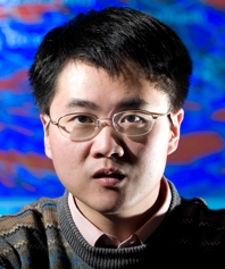
ASSOCIATE PROFESSOR
Office Phone: 307-223-1126
Fax Phone: (307) 766-6679
Office: ESB 2036
Email: pchen@uwyo.edu
Education
Seismology, PhD, University of Southern California, 2005
Geophysics, BS, Beijing University, 2000
Economics, BS, Beijing University, 2000
teaching statement
I am a firm believer in active learning. The point of teaching is not to throw information at students, but to assist them in comprehending new knowledge and transforming that knowledge into problem-solving skills in their own research. I believe that knowledge learned through experimenting and practicing can last a lifetime. My feeling is that teaching is a mutual experience and requires effective communication between students and the teacher. An instructor needs constant feedback from the students in order to adjust teaching material and style to meet the students' learning needs. In particular, students' questions about important concepts need to be addressed immediately. Technology is useful and should be used effectively. I feel that "seeing is believing". I encouraged the use of existing software packages for teaching purposes. Many open-source software packages have been developed and distributed to assist seismologists in their research. Finally, I do not see a rigid dividing line between research and teaching. Good teachers need to be at the forefront of their research areas in order to show students the dynamism of our work. In my teaching experience, I always tried to demystify cutting-edge research ideas for students. I believe this will encourage them to discover and explore the excitement that can be found in researching our planet.
graduate students
- En-Jui Lee - PhD Candidate
- Dawei Mu - PhD Candidate
- Jing Xu - PhD Candidate
- Xiaofeng Zhang - MS Candidate
research statement
A major focus of seismological research today concerns how to construct Earth structure and seismic source models from the rich waveform information recorded by modern broadband seismic instruments. Recent advances in parallel computing technology and numerical methods have made large-scale 3D numerical simulations of seismic wavefields much more affordable, which opens up the possibility for full-3D waveform tomography (F3DT) and seismic source parameter inversions in 3D Earth structure models. By "full-3D", I mean that both the starting model and the derived model perturbations are 3D in space and the Fréchet kernels are constructed using the full physics of 3D wave propagation. F3DT can account for the nonlinearity of the structural inverse problem through iterations, therefore provides the most efficient means for assimilating seismic observations into dynamic ground-motion models. Moreover, unlike in ray-theoretic tomography or even the finite-frequency tomography based on asymptotic ray theory, F3DT is based on exact numerical solutions of the 3D wave equation, therefore eliminates all mathematical approximations in classical structural tomography practices and is capable of providing seismic structure and source models with unprecedented accuracy and resolution.
publications
Links to Publications in PDF format
[8] Resolving Fault-plane-ambiguity for Small Earthquakes, Po Chen, Thomas H. Jordan and Li Zhao, 2007, Bulletin of Seismological Society of America, submitted.
[7] Full 3D Tomography for Crustal Structure of the Los Angeles Region, Po Chen, Li Zhao and Thomas H. Jordan, 2007, Bulletin of Seismological Society of America, Vol. 97, No. 4, pp. 1094-1120, doi: 10.1785/0120060222
[6] Full 3D Waveform Tomography: A Comparison Between the Scattering-Integral and Adjoint-Wavefield Methods. Po Chen, Thomas H. Jordan and Li Zhao, 2007, Geophysical Journal International, DOI: 10.1111/j.1365-246X.2007.03429.x.
[5] Seismic Velocity Variations on the San Andreas Fault at Depth Caused by the 2004 M6 Parkfield Earthquake and Their Implications, Yong-Gang Li, Po Chen, Elizabeth S. Cochran and John E. Vidale, 2007, Earth Planets Space, 59, 21-31.
[4] Strain Green's Tensors, Reciprocity and Their Applications to Seismic Source and Structure Studies, Li Zhao, Po Chen and Thomas H. Jordan, 2006, Bulletin of Seismological Society of America, Vol. 96, No. 5, pp. 1753-1763.
[3] Seismic Evidence for Rock Damage and Healing on the San Andreas Fault Associated with the 2004 M6 Parkfield Earthquake, Yong-gong Li, Po Chen , John E. Vidale, Elizabeth S. Cochran and Thomas Burdette, Bulletin of Seismological Society of America, September 2006, Vol. 96, No. 4, pp. S1-S15, doi: 10.1785/0120050803.
[2] Fréchet Kernels for Imaging Regional Earth Structure Based on Three-dimensional Reference Models, Li Zhao, Thomas H. Jordan and Kim B. Olsen and Po Chen, 2005, Bulletin of Seismological Society of America, Vol. 95, No. 6, pp. 2066-2080.
[1] Finite Moment Tensor of the 3 September 2002 Yorba Linda Earthquake, Po Chen, Li Zhao and Thomas H. Jordan, June 2005, Bulletin of Seismological Society of America, Vol. 95, No. 3, pp. 1170-1180.

